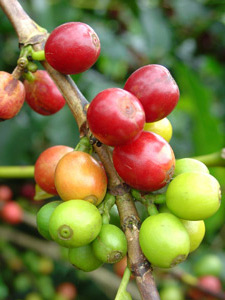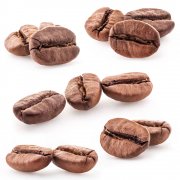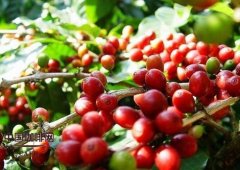American Coffee region Coffee Bean area
Columbia (Colombian) aroma 3.5 minutes brightness 4.5 minutes mellow 3.5 minutes flavor 4.5 points aftertaste 4.5 points
Suitable for baking: Medial/City/Full city/Espresso/Dark/French Columbia beans are one of the few coffee beans that range from shallow roasting to very deep roasting, from clean light roasting to deep roasting sweetness, in such a wide range
Columbia beans will have different styles and features.
Once the second largest coffee producer after Brazil, Colombia, now the world's largest supplier of washed beans, has been overtaken by Vietnam. Colombia has become synonymous with good coffee after years of image-building. Despite the balanced flavor, thick texture, famous sour taste and aroma, most Colombian beans are mediocre and have no personality if you taste them carefully. When choosing Colombian beans, you should not only look at the grade marks, but also pay attention to the producing areas, because Colombia is currently graded according to the size of beans, so the Supremo or Excelso on the coffee bag refers to the size of beans rather than the quality, but the size of beans is not necessarily related to the flavor of the entrance, but is closely related to the altitude of the place of origin and taste, so this grading system is often criticized. In fact, most of the medium,
South American countries have switched to altitude classification, and only Colombia maintains this traditional classification system, which many Colombian coffee makers have recognized and have begun to demand a change in the classification system. Colombia's famous producing areas include Medellin, Armenia and Manisales, so the word MAM is sometimes seen on coffee bags, indicating that the coffee beans may come from any of these three producing areas. Almost all of Colombia's finest coffee beans come from traditional small farms, which grow old coffee trees from Typica, which are well planted and carefully harvested and treated, so they are of high quality but relatively low in yield.
Costa Rica (Costa Rica) aroma 3.5 minutes brightness 4.5 minutes mellow 3 minutes flavor 4.5 points aftertaste 4.5 points
Suitable for baking: if Light/Medial/City wants to show the perfectly balanced flavor of Costa Rica, it can never be baked deeply, it is recommended that the degree of City can be done, or even the beans can be added as soon as the first explosion is over, at this time the flavor and flavor will be both, close to the second explosion is the deepest limit of baking, do not enter the second explosion and waste the best coffee beans.
Costa Rican coffee is praised as "complete coffee" by many gourmets, because it is very balanced, the flavor is very clean and tight, the delicate sour taste with green apple (sometimes citrus or plum fruit), the body is tight but not thin, and the sweetness of the coffee will stay in the throat for a long time, so some people describe it as "perfectly balanced"! The best Costa Rican coffee has a chocolate flavor in its aftertaste. There are a total of 130, 000 coffee farms in Costa Rica. The most famous producing areas are Tarrzu, near the southern Pacific coast, and Tres Rios, north of San Jose, the capital. These areas have high altitude and good soil, so they have the densest planting density and stable coffee quality. Among these many coffee farms, the most famous is located in Tarasu. LaMinita Manor, which tastes as clear as a bell, the coffee at LaMinita is so good because it is careful and strict in everything from the planting of coffee trees to the handling of coffee beans. in fact, the estate produces not a small number of coffee beans a year, but very few of them are sold under the name of LaMinita, and the rest are selected to be sold only as beans from the Tarasu region. Because Tarasu is so famous, the fame of other producing areas is less known to the world, such as the Bols volcanic area and the Sanshui River producing area. The three major volcanic areas even produce excellent coffee in Orosi and so on on the north side of the Atlantic Ocean. Another problem with strong brands is that many coffees that are not produced in Tarasu are also mixed with fish eyes and pictures of Tarasu, so it is the only way to try it in person.
Guatemala (Guatemala) aroma 3.5 minutes brightness 4.5 minutes mellow 3.5 minutes flavor 4.5 points aftertaste 4.5 points
Suitable for baking: Light/Medial/City shallow roasting, city can best show the characteristics of Guatemalan coffee, too deep will reduce the fragrance of the fruit, if you like the smoky taste, you can bake close to the second burst, but still do not enter the second burst as the principle.
As the United States is deeply involved in coffee agriculture and is heavily exploited, huge North American multinational groups control most of the producing areas and produce low-altitude, low-quality coffee at very low wages. These shoddy coffees don't represent real Guatemalan coffee. In fact, Guatemala has unique planting conditions, and many producing areas have ideal altitude, soil and climate conditions, so they can produce the most complex and delicate coffee in the world. The most famous is Antigua in the volcanic area, where coffee is famous for its smoky taste and the performance of spices and fruit acids is not poor. Huehuetenango in the north is more fruity, but slightly lighter than Antigua. In addition, coffees such as Kovan, Frejanis and Kitcher also have their own characteristics, and coffee from Atitland has occasionally been produced in recent years.
El Salvador (El Salvador) aroma 4 minutes brightness 4.5 minutes mellow 3 minutes flavor 4.5 points aftertaste 4.5 points
Suitable for baking: if City/Full city city has a preference for heavy flavor, it doesn't hurt to bake it a little deeper.
Most people remember El Salvador as a place with frequent wars, but it is true that years of civil war have prevented El Salvador's coffee beans from standing out in the international market. in fact, El Salvador has three conditions: soil, height and climate. It should not be difficult to produce coffee as spectacular as Guatemala and Costa Rica, and coffee could be grown in El Salvador as early as the 19th century. It was once even the most important cash crop in the country. In recent years, El Salvador has a stable political situation and an open market economy, so its coffee beans have gradually come to the fore in the international market. Most of the Salvadoran coffee is certified organic coffee, the taste is fresh and bright, the fruit flavor is also rich, the flavor is slightly thicker than the beans of neighboring countries, the overall pull is quite good, I believe that it will be better and better in the future.
Panama (Panama) aroma 3.5 minutes brightness 4.5 minutes mellow 3.5 minutes flavor 4.5 points aftertaste 4.5 points
Suitable for baking: Light/Medial/City shallow to medium baking, shallow to the end of the first explosion; do not enter the second explosion at the deepest, otherwise it will damage its clean brightness and reduce its complexity.
Coffee dealers often joke: "good Hawaiian beans are actually Panamanian beans, good Jamaican blue beans are Panamanian beans, and good Costa Rican beans are actually Panamanian beans." Although it is a joke, what is revealed is the high praise of Panamanian beans in the boutique coffee world! Panamanian coffee beans are cheap, high-quality and stable, and often easily surpass other famous coffee beans, which is why many Panamanian beans are passed off as other high-priced beans. High-end Panamanian coffee beans have a complex and pure flavor, with just the right mellow and bright taste, it is not too much to call it the most valuable coffee. Panamanian coffee is grown at a high altitude, and many famous estates are operated for generations, with a long tradition and rich experience, so the coffee produced is naturally of high quality.

Important Notice :
前街咖啡 FrontStreet Coffee has moved to new addredd:
FrontStreet Coffee Address: 315,Donghua East Road,GuangZhou
Tel:020 38364473
- Prev

Introduction to Latin American Coffee
Columbia (Colombian) aroma 3.5 minutes brightness 4.5 minutes mellow 3.5 minutes flavor 4.5 minutes aftertaste 4.5 minutes suitable for baking degree: Medial/City/Full city/Espresso/Dark/French Columbia beans are a small number of roasted coffee beans ranging from shallow roasting to very deep roasting, from light roasting clean brightness to deep roasting sweetness, in such a wide range, Colombian beans will
- Next

The most representative producing area of Sulawesi is Traga.
Sulawesi (Sulawesi) aroma 3.5 minutes brightness 4 mellow 4 flavor 4 aftertaste 4 points suitable for baking degree: City/Full city full city is the best to start the pot just before the second explosion. Because the color of Sulawesi is not dark when baking, it is easy to overdo it if you use color as the standard of baking. Sulawesi is also known as Cyberis, which is actually
Related
- Beginners will see the "Coffee pull flower" guide!
- What is the difference between ice blog purified milk and ordinary milk coffee?
- Why is the Philippines the largest producer of crops in Liberia?
- For coffee extraction, should the fine powder be retained?
- How does extracted espresso fill pressed powder? How much strength does it take to press the powder?
- How to make jasmine cold extract coffee? Is the jasmine + latte good?
- Will this little toy really make the coffee taste better? How does Lily Drip affect coffee extraction?
- Will the action of slapping the filter cup also affect coffee extraction?
- What's the difference between powder-to-water ratio and powder-to-liquid ratio?
- What is the Ethiopian local species? What does it have to do with Heirloom native species?

